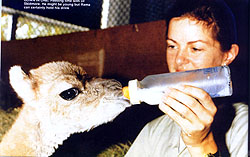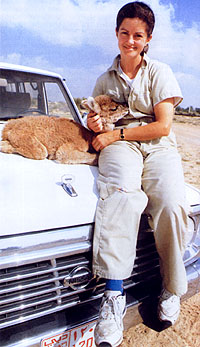 After being extinct for over 30 million years the cama, the common ancestor of the camel and the llama has been re-introduced to the world. But is it right to interfere with nature? Frank Stamford spoke to Dr. Lulu Skidmore, the doctor reponsible, who explained the purpose behind this this intriguing experiment.
After being extinct for over 30 million years the cama, the common ancestor of the camel and the llama has been re-introduced to the world. But is it right to interfere with nature? Frank Stamford spoke to Dr. Lulu Skidmore, the doctor reponsible, who explained the purpose behind this this intriguing experiment.
UNLESS your head has been buried in the sand for the past two months, you would have heard the one that goes: what do you get if you cross a camel with a llama?
The answer is cama, but this little mutant is no joke. The species has been re- created by the UAE's own Mother Nature, Dr Lulu Skidmore, technical director at the Camel Reproduction Centre in Dubai.
The attractive 34-year-old British-born scientist is certainly not the picture many paint of an elderly, grey-haired Mother Nature, but the revolutionary work performed by her team at the high-tech Centre has succeeded in bringing new life to a planet which all too frequently takes it away.
The world's first cama was born on 14 January and is affectionately named Rama due to it arriving in the Holy Month of Ramadan.
"I like to think that we have introduced something new that can be of use," said Dr Skidmore. "Mankind has contributed to the extinction of many species of plant and animal so it is nice to give something back."
Dr Skidmore claims she is not creating a new animal, but turning the evolutionary clock back.
Historians believe that the common ancestor of camels and llamas lived in North America. Subsequently the two species split and went their separate ways - ancestors of camels made their way to Africa across a land bridge over the Bering Strait, while those of llamas headed south to the mountains.
This sort of work has raised cautionary eyebrows across the world. Many people frown upon these experiments, claiming they are interfering with nature. Dr Skidmore disagrees. She is in no doubt that what they are doing is not tampering with nature but helping and enhancing it, although she does admit that one of the early driving forces was that "no-one else had done anything like this before".
 "It is not as if we are crossing an elephant and a giraffe," she said: "We are not doing experiments under a microscope and certainly not fiddling with these animals' genes.
"We are simply putting the clock back 30 million years because the camel and the llama were once the same animal.
"It is not as if we are crossing an elephant and a giraffe," she said: "We are not doing experiments under a microscope and certainly not fiddling with these animals' genes.
"We are simply putting the clock back 30 million years because the camel and the llama were once the same animal.
"Crossing similar animals that evolved from one creature millions of years ago has proved very successful in the past and we hope this turns out to be likewise. The horse and the donkey evolved from the same animal six million years ago. Cross breed the two and you get the mule which has turned out to be very useful in many poor countries.
"We want to get the best of both breeds by crossing the camel with the llama to come up with a unique animal. We hope that it's size will be somewhere between the two and be covered by a woolly coat. This will make it a much more manageable animal that will be good for the wool trade."
The llama is an animal more at home in the colder climates of southern America while the camel revels in warm, dry countries. Dr Skidmore explained that by introducing a medium of the two the cama can be an effective animal in both climates.
"It could become a very useful creature - a very good carrier that could live in extreme climates as that is usually where people rely on animals for transport," she said.
So how was the world's latest species created? It certainly took a lot of hard work which, for long periods, appeared that it wasn't going to be successful.
A female llama was artificially inseminated with sperm from a male camel and after numerous disappointments, Rama was born a healthy baby boy. This ground-breaking experiment received active support from General Sheikh Mohammed Bin Rashid Al Maktoum, Crown Prince of Dubai and UAE Minister of Defence, who not only funded the project but took a personal interest. He was one of the first people to see Rama at the centre when he was born.
After the idea was struck up, almost three years ago, a plan was set in motion where frozen llama semen was flown from a ranch in Montana to an eager camel here in the UAE. "Three lots were brought over in the early days but all failed," said Dr Skidmore, who admitted she had second thoughts following these early frustrations.
But then she realised there was an easier method right under her nose, across the road at Sheikh Mohammed's own private wildlife farm where llamas were in residence. This curtailed the need for frozen semen to be dashed across the Atlantic, but they were obviously still doing something wrong because there was no sign of success.
"During the course of the experiment, we had three hybrid pregnancies but two resulted in foetal death or still-birth," she said. Hope seemed to be fading for a successful conception, but when it did come, Dr Skidmore said it was well worth the patience.
Rama's conception was made possible by modern reproductive technology. Ovarian follicular development in his mother was monitored by rectal ultrasound. When a ripe follicle was detected, she was inseminated with fresh camel semen, and then ovulation was induced by a hormone injection. Ovulation was confirmed by ultrasound and constant monitoring was undertaken during the pregnancy until the llama finally went into labour after 328 days of pregnancy.
Dr Skidmore speaks Rama as if it is her own child, but her enthusiasm is understandable because, after all, Rama is her creation.
"I do tend to refer to him as 'my baby' and I suppose I spend as much time looking after him as I would a human baby," said the very proud 'mother'.
"The past three years produced a lot of disappointments with still births, but when you see Rama, it makes all the work worthwhile and gives you the encouragement to go on."
The new arrival has produced a whole host of media interest and Dr Skidmore has a cuttings book of articles from around the world. "I've been amazed by all the Press coverage from abroad," she said. "My baby has appeared in so many papers and my family has sent me clippings from several national newspapers in the UK."
But Dr Skidmore is a modest and unassuming woman who has brushed aside the celebrity spotlight: "I think Rama is the real star of the show," she said.
Dr Skidmore said Rama is making good progress and putting on weight at an expected rate. Another camel at the centre has just given birth and she is using milk from that camel for Rama.
Bottle feeding takes place every three hours during the day and every five hours at night, but supervision is required at all times so Dr Skidmore has virtually set up home in Rama's pen.
"I share the supervision at nights with someone else but I think I have spent more nights with Rama than I have at home since his birth," she said.
Rama's life expectancy is up to 40 years which is the age that a healthy camel can live to (llamas have a shorter life span), but of course it is impossible to say as Rama is one of a kind... at the moment!
"We are hoping to produce some more," continued Dr Skidmore. "It would be nice to have a good herd and we will keep working at it. If it was that easy we would have hundreds of them by now."
The work being done at the Camel Reproduction Centre is receiving admirers world-wide and the Americans are keen to share the technology that Dr Skidmore has been using.
"I don't know if this particular cross will work worldwide," she said. "Freezing semen and sending it did not seem to working.
"It's been easier for us as we have the two animals in the same place which is not that common. Llamas and camels are from two very different climates.
"Having said that, the llamas we have been using here have acclimatised very well and seem happy. Just like humans, they need to adapt to the conditions they live in and the llamas do that very well. They are reproducing which is a good sign."
The next dramatic development will be when a cama reproduces naturally or even artificially. "If the animals are fertile then it is quite possible," she said. "We will not be able to tell until Rama reaches puberty which will not be for another three to four years but we are certainly hopeful that the cama will be able to breed naturally like any other animal."
Dr Skidmore arrived in Dubai in 1989 after Sheikh Mohammed set up a laboratory for embryo transfer and artificial insemination to produce better racing camels.
The Maktoum family wanted to transfer technology used in developing race horses to camels and Dr Skidmore, then a research assistant, came to the UAE with Professor W.R. Allen and Dr M.J. Cooper, both from the Newmarket-based Equine Fertility Clinic.
Despite only previously working with horses and cattle, the team were successful with camels. The Camel Reproduction Centre, comprising an air-conditioned enclosure for housing and treating camels, a well-equipped lab for handling semen and embryos and 100 camels for research purposes, provided the perfect base to carry out their experiments.
In 1991, after Allen and Cooper returned to the UK, Dr Skidmore assumed greater responsibility and moved to Dubai full time. During this period she has completed a PhD in Camel Reproduction from Cambridge University.
This was in addition to a Bachelor's degree in Animal Science from London University.
So what next after Rama the cama?
"The Llamel," said Dr Skidmore in a light-hearted manner while remaining deadly serious about her answer. "We are determined to be successful in the reverse cross because we believe the female camel should be able to conceive easier. So far we have been proved wrong but we are determined to get that alive and kicking.
"There are numerous fields we are working on at the moment as well and we want to do some research on frozen embryos and transporting frozen semen. The reason for this is to improve the population of camels where people need them most for food and transport like Africa. They don't have the technology in countries like that and we have the research and facilities to help."
Dr Skidmore will be the last to admit that she is some sort of miracle worker, but without her, the world would not have its first ever cama.